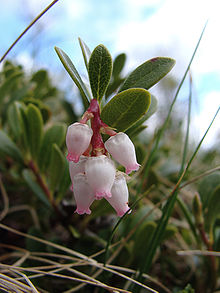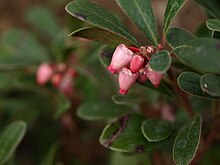Arctostaphylos uva-ursi
| Arctostaphylos uva-ursi | |
|---|---|

| |
| Scientific classification | |
| Kingdom: | Plantae |
| Clade: | Tracheophytes |
| Clade: | Angiosperms |
| Clade: | Eudicots |
| Clade: | Asterids |
| Order: | Ericales |
| Family: | Ericaceae |
| Genus: | Arctostaphylos |
| Species: | A. uva-ursi
|
| Binomial name | |
| Arctostaphylos uva-ursi (L.) Spreng.
| |




Arctostaphylos uva-ursi is a plant species of the genus Arctostaphylos widely distributed across circumboreal regions of the subarctic Northern Hemisphere.[2] Kinnikinnick (First Nations for "smoking mixture") is a common name in Canada and the United States.[2][3][4] It is one of several related species referred to as bearberry.[2][5]
Its specific name uva-ursi means "grape of the bear" in Latin (ūva ursī), similar to the meaning of the generic epithet Arctostaphylos ("bear grapes").
Etymology and common names[]
The genus name of Arctostaphylos uva-ursi comes from the Greek words arctos (meaning bear) and staphyle (meaning "bunch of grapes") in reference to the fruits which form grape-like clusters.[2][3][6] In the wild, the fruits are commonly eaten by bears.[6] The specific epithet, uva-ursi, comes from the Latin words uva (meaning grape) and ursus (bear), reflected by the bearberry nickname.[6][7]
The common name, kinnikinnick, is an Algonquin word meaning "smoking mixture".[3][6] Native Americans and early pioneers smoked the dried uva-ursi leaves and bark alone or mixed with other herbs, tobacco or dried dogwood bark in pipes.[6] Numerous common names exist, depending on region, such as mealberry, sandberry, mountain-box, fox-plum, hog-crawberry, and barren myrtle.[3]
Distribution[]
The distribution of Arctostaphylos uva-ursi is circumpolar, and it is widespread in northern latitudes,[2][8][4] but confined to high altitudes further south:
- in Europe, from Iceland and North Cape, Norway south to southern Spain (Sierra Nevada); central Italy (Apennines) and northern Greece (Pindus mountains);
- in Asia from arctic Siberia south to Turkey, the Caucasus, the Levant and the Himalaya;
- in North America from arctic Alaska, Canada and Greenland, south to California, north coast, central High Sierra Nevada (above Convict Lake, Mono County, California), Central Coast, California, San Francisco Bay Area, to New Mexico in the Rocky Mountains; and the Appalachian Mountains in the northeast United States. It is prevalent across all regions of British Columbia and Alberta.[2][3] The plant is rare or endangered in several states of the Midwestern United States.[4]
Description[]
Arctostaphylos uva-ursi is a small procumbent woody groundcover shrub 5–30 cm (2–12 in) high.[6] The leaves are evergreen, remaining green for 1–3 years before falling. The fruit is a red berry.[9]
The leaves are shiny, small, and feel thick and stiff.[6] They are alternately arranged on the stems. Undersides of leaves are lighter green than on the tops.[9] New stems can be red if the plant is in full sun, but are green in shadier areas. Older stems are brown. In spring, they have white or pink flowers.[2]
Wild stands of Arctostaphylos uva-ursi can be dense, with heights rarely taller than 6 inches. Erect branching twigs emerge from long flexible prostrate stems, which are produced by single roots. The trailing stems will layer, sending out small roots periodically. The finely textured velvety branches are initially white to pale green, becoming smooth and red-brown with maturity. The small solitary three-scaled buds are dark brown.
The simple leaves of this broadleaf evergreen are alternately arranged on branches. Each leaf is held by a twisted leaf stalk, vertically. The leathery dark green leaves are an inch long and have rounded tips tapering back to the base. In fall, the leaves begin changing from a dark green to a reddish-green to purple, becoming pale on the underside.[6]
Terminal clusters of small urn-shaped flowers bloom from May to June. The flowers are white to pink,[9] and bear round, fleshy or mealy, bright red to pink fruits called drupes.[2] The smooth, glossy skinned fruits range from 1⁄4 to 1⁄2 inch (6 to 13 mm) in diameter. The fruit persist on the plant into early winter. The fruits are bittersweet when raw, but sweeter when boiled and dried. Fruits are edible for humans, but are generally considered to be unpalatable.[6] Each drupe contains 1 to 5 hard seeds, which need to be scarified and stratified prior to germination to reduce the seed coat and break embryo dormancy. There is an average of 40,900 cleaned seeds per pound.[4] It is a fire-tolerant species and may be a seedbanking species.[2]
Bears and other animals eat the berries.[10]
Pathology[]
Arctostaphylos uva-ursi is an alternate host for spruce broom rust.[11]
Subspecies[]
There are some 14 subspecies,[8] including:
- Arctostaphylos uva-ursi subsp. uva-ursi. Common bearberry; circumpolar arctic and subarctic, and in mountains further south.
- Arctostaphylos uva-ursi subsp. adenotricha. Central high Sierra Nevada.
- Arctostaphylos uva-ursi subsp. coactilis. North coastal California, central coast California, San Francisco Bay Area.
- Arctostaphylos uva-ursi subsp. cratericola (J. D. Smith) P. V. Wells. Guatemala bearberry, endemic to Guatemala at very high altitudes (3000–4000 m).
- Arctostaphylos uva-ursi subsp. longifoliosa. Various reports from Canada, U.S.A.[12] May be the same as adenotricha or coactilis.
For a list of reported North American subspecies and varietals, see USDA Plants Profile.[8]
Uses[]
Phytochemicals[]
The plant contains diverse phytochemicals, including ursolic acid, tannic acid, gallic acid, some essential oils and resin, hydroquinones (mainly arbutin, up to 17%), tannins (up to 15%), phenolic glycosides and flavonoids.[13] Arctostaphylos uva-ursi leaves contain arbutin,[14][15] which metabolizes to form hydroquinone, a potential liver toxin.[15][16]
Food[]
Historically, bearberry fruits and leaves were used by the Blackfeet Nation as food.[17] The fruits are fairly bland when raw[18] but can be used to make jelly.[11] The berries were used as seasoning and cooked with meat.[19]
Dye[]
Native Americans used the plant to make yellow dye.[11]
Smoking[]
Dried bearberry leaves are the main component in many traditional North American Native smoking mixes,[3][20] known collectively as "kinnikinnick" (Algonquin for "smoking mixture") used especially among western First Nations, often including other herbs and sometimes tobacco.[3][6][14]
Traditional medicine[]
Teas and extracts of the leaves have been used in traditional medicine of First Nations people over centuries as urinary tract antiseptics, diuretics, and laxatives.[14] In herbalism, leaf tea is used to treat urinary tract inflammation.[14] Though thought to be an astringent[21] or cure for sexually transmitted diseases,[22][citation needed] as of 2017, there was no high-quality evidence from clinical research that such treatments are effective or safe.[14]
Precautions and adverse effects[]
One review indicated that ingestion of large doses can cause allergic reactions, with nausea and seizures, as a potential emergency condition.[14] Preliminary studies indicate that arbutin may be toxic when ingested in high doses.[15] Uva ursi may cause adverse effects in people with liver or kidney disease, or pregnant and breastfeeding women.[14]
Cultivation[]
There are several cultivars that are propagated for use as ornamental plants.[3] It is an attractive year-round evergreen groundcover for gardens, and is useful for controlling erosion on hillsides and slopes due to its deep roots.[6] It is tolerant of sun and dry soils, and is thus common groundcover in urban areas, in naturalized areas, and in native plant or rock gardens.[2][6]
References[]
- ^ "Arctostaphylos uva-ursi". NatureServe Explorer. NatureServe. Retrieved 2018-07-18.
- ^ Jump up to: a b c d e f g h i j "Arctostaphylos uva-ursi (L.) Spreng; E-Flora: Electronic atlas of the flora of British Columbia; In: Klinkenberg, Brian. (Editor)". E-Flora BC, Department of Geography, University of British Columbia Herbarium. 2018. Retrieved 2019-08-27.
- ^ Jump up to: a b c d e f g h "Common bearberry". Alberta Plant Watch, Government of Alberta. 2019. Retrieved 2019-08-27.
- ^ Jump up to: a b c d "Plant fact sheet: Bearberry (Arctostaphylos uva-ursi)" (PDF). USDA NRCS Northeast Plant Materials Program. 31 January 2002.
- ^ Casebeer, M. (2004). Discover California Shrubs. Sonora, California: Hooker Press. ISBN 0-9665463-1-8.
- ^ Jump up to: a b c d e f g h i j k l "Arctostaphylos uva-ursi; 'Massachusetts'". Missouri Botanical Garden. 2019. Retrieved 27 August 2019.
- ^ Wells, Philip V. (2000). The Manzanitas of California. Lawrence, KS: University of Kansas. p. 13. ISBN 978-0-933994-22-5.
The name Arctostaphylos is from Greek: arctos = bear, staphylos = bunch of grapes or berries; hence bearberry, pertaining redundantly to A. uva-ursi (Latin: uva = berry, ursi = of the bear).
- ^ Jump up to: a b c "Plants profile for Arctostaphylos uva-ursi (kinnikinnick)". USDA Plants. 2019. Retrieved 2019-08-27.
- ^ Jump up to: a b c Clapham, Arthur; Tutin, Thomas; Warburg, Frederic (1989). Excursion Flora of the British Isles (Third ed.). Cambridge University Press. p. 231. ISBN 0521232902.
- ^ Reiner, Ralph E. (1969). Introducing the Flowering Beauty of Glacier National Park and the Majestic High Rockies. Glacier Park, Inc. p. 114.
- ^ Jump up to: a b c Patterson, Patricia A. (1985). Field Guide to the Forest Plants of Northern Idaho (PDF). United States Department of Agriculture Forest Service. p. 37–47.
- ^ Elven, Reidar (ed.). Pan-arctic Flora.
- ^ Pegg, Ronald B.; Rybarczyk, Anna and Amarowicz, Ryszard (2008). "Chromatographic separation of tannin fractions from a bearberry leaf (Arctostaphylos Uva-ursi L. Sprengel) extract by Se-HPLC". Polish Journal of Food and Nutrition Sciences. 58 (4): 485–490. doi:10.17221/234/2008-cjfs. S2CID 37247418.CS1 maint: uses authors parameter (link)
- ^ Jump up to: a b c d e f g "Uva ursi". Drugs.com. 19 July 2017. Retrieved 27 August 2019.
- ^ Jump up to: a b c "Arbutin, CID 440936". PubChem, National Library of Medicine, US National Institutes of Health. 16 November 2019. Retrieved 19 November 2019.
- ^ De Arriba, S. G; Naser, B; Nolte, K. U (2013). "Risk assessment of free hydroquinone derived from Arctostaphylos Uva-ursi folium herbal preparations". International Journal of Toxicology. 32 (6): 442–53. doi:10.1177/1091581813507721. PMID 24296864. S2CID 24225098.
- ^ Hellson, John C. (1974). Ethnobotany of the Blackfoot Indians. Ottawa: National Museums of Canada. p. 101.
- ^ Benoliel, Doug (2011). Northwest Foraging: The Classic Guide to Edible Plants of the Pacific Northwest (Rev. and updated ed.). Seattle, WA: Skipstone. p. 107. ISBN 978-1-59485-366-1. OCLC 668195076.
- ^ Sanderson, Helen; Renfrew, Jane M. (2005). Prance, Ghillean; Nesbitt, Mark (eds.). The Cultural History of Plants. Routledge. p. 99. ISBN 0415927463.
- ^ Moerman, Daniel E. "Arctostaphylos uva-ursi". Native American ethnobotany. pp. 87–88. ISBN 0-88192-453-9.
- ^ Niering, William A.; Olmstead, Nancy C. (1985) [1979]. The Audubon Society Field Guide to North American Wildflowers, Eastern Region. Knopf. p. 497. ISBN 0-394-50432-1.
- ^ Whitney, Stephen (1985). Western Forests (The Audubon Society Nature Guides). New York: Knopf. p. 418. ISBN 0-394-73127-1.
External links[]
| Wikimedia Commons has media related to Arctostaphylos uva-ursi. |
- NatureServe secure species
- Arctostaphylos
- Berries
- Flora of Europe
- Flora of Asia
- Flora of North America
- Natural history of the California chaparral and woodlands
- Native American culture
- Smoking in the United States
- Garden plants of Asia
- Garden plants of Europe
- Garden plants of North America
- Groundcovers
- Medicinal plants
- Plants used in Native American cuisine

